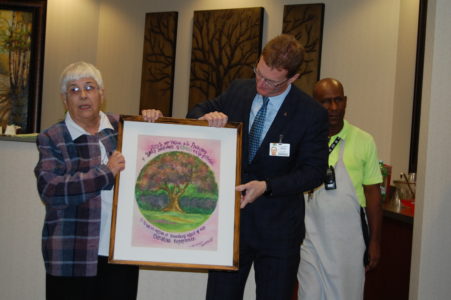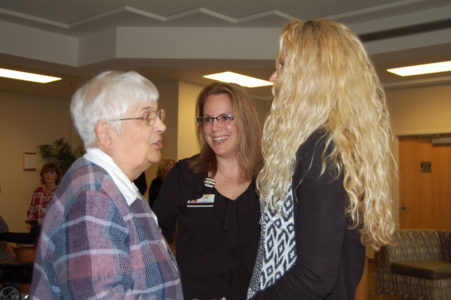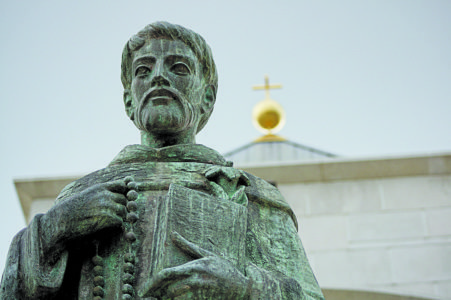By Maureen Smith and Elsa Baughman
JACKSON – On Tuesday, Nov. 29, Sister Paulinus Oakes, RSM, and a few friends gathered for the dedication in her honor of “The Oakes,” a unit in the Behavioral Health building at St. Dominic Hospital.
The Oakes provides compassionate care for those with psychiatric conditions secondary to a cognitive disorder such a dementia and those suffering from depression or other acute mental illnesses. Treatments include social and group therapy, one-on-one therapy and family support and education. It has been open for several years, but was only recently renamed in honor of Sister Oakes.

Sister Paulinus Oakes, RSM, donated a painting by a fellow sister to the unit.
“The reasoning for naming the unit The Oakes is for all of sister’s dedication and service to our patients and the community,” explained Kim Mathis, director of outreach services for St. Dominic Behavioral Health Services. “She worked at St. Dominic’s for 16 years and was a faithful servant to those less fortunate and always had a heart for those suffering with mental illness and alcohol and drug abuse,” she added.
“Thank you for doing this for me. I was choked up out of my mind when I learned about this honor,” she said. As is her custom, she brought a gift with her to the dedication, a painting by a fellow sister to hang in the unit. Sister Oakes declined to talk about the honor, wanting instead to talk about the painting and the sister who donated it.
“No one has a heart for the homeless, down-and-out and those who are considered ‘the least’ by society quite like Sister Paulinus,” said Pat Walden, director of pastoral care for St. Dominic. “By her life and example, she showed us that they need love and care,” she added.
Sister Oakes, a native of Vicksburg, started working at St. Dominic’s in 1996 as chaplain for behavioral health. Trace Swartzfager, vice-president of business development at St. Dominic’s, introduced Sister Oakes and noted he started working at the hospital the same day she did and was beyond thrilled when he realized who she was. “This was the Sister Paulinus who was known for her unwavering passion for helping those suffering from chemical dependency and psychiatric disorders,” he said.
“I can’t tell you what a joy it was working with Sister Paulinus during her tenure here at St. Dominic’s,” he added.
Swartzfager commented he received routine phone calls from referring physicians telling him they were sending their patient to St. Dominic “because I know Sister Paulinus is there and I am confident my patient will be well cared for.” He said that when they starting brainstorming about names for the new patient care unit, the name “The Oakes” came to mind immediately.
Present at the dedication were retired Bishop Joseph Latino, Msgr. Elvin Sunds, several priests, a large group of Sisters of Mercy, lay Mercy Associates friends and members of the hospital personnel.
Sister Oakes has masters degree from Xavier University in St. Louis and Loyola University in New Orleans. She also served as school principal and taught in various Mercy school in Mississippi and Oklahoma.

Sister Paulinus Oakes, RSM, speaks with staff at the behavioral health unit now named in her honor at St. Dominic’s Hospital. (Photos by Elsa Baughman)
For more than 20 years she was an adjunct faculty member for Hinds Community College in Hinds and Warren counties teaching American literature. She volunteered with the National Council of Alcoholism and Drug Dependence (NCADD) for more than 18 years and was one of the founders of Born Free, a residential treatment program for women.
She has also published to books. Last year she retired to her order’s motherhouse in St. Louis, Mo.

